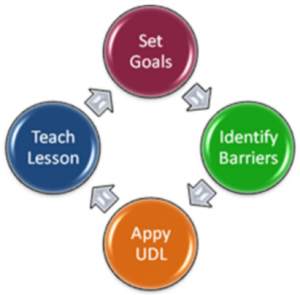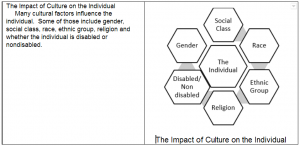 Communicating information through multiple modalities (visual, auditory, tactile, kinesthetic) enables students to access information. Learners differ in the ways that they perceive and comprehend information that is presented to them. For example, those with sensory disabilities (e.g., blindness or deafness); learning disabilities (e.g., dyslexia); language or cultural differences, and so forth may all require different ways of approaching content (Universal Design for Learning, Principle 1, 2014). While this seems complex, awareness of this concept lends to integration. For example, providing a clear visual presentation of a course assignment in class combined with an oral presentation and discussion with students offers active engagement through visual, oral and active engagement as students comprehend the criteria, ask questions and take-notes. Exploring other aspects of communicating information may offer insight for meeting the invisible learner’s needs. Active engagement plays a critical role in student learning.
Communicating information through multiple modalities (visual, auditory, tactile, kinesthetic) enables students to access information. Learners differ in the ways that they perceive and comprehend information that is presented to them. For example, those with sensory disabilities (e.g., blindness or deafness); learning disabilities (e.g., dyslexia); language or cultural differences, and so forth may all require different ways of approaching content (Universal Design for Learning, Principle 1, 2014). While this seems complex, awareness of this concept lends to integration. For example, providing a clear visual presentation of a course assignment in class combined with an oral presentation and discussion with students offers active engagement through visual, oral and active engagement as students comprehend the criteria, ask questions and take-notes. Exploring other aspects of communicating information may offer insight for meeting the invisible learner’s needs. Active engagement plays a critical role in student learning.
Visual Information and Strategies
Providing clear visual images proves critical in accessing information. The brain intakes visual information and either scans it or stores it in short-term or long-term memory. If the images processed are unclear, the information retrieved will be unclear. Factors that affect perceptual processing include; size of text, images, graphs, tables, contrast between background and text or image, color, layout and font. Crisp, clear images with contrast between text and background create the best impression for memory. Compare the information below, both in size 10 font, but portrayed differently. The graphic on the right creates a clear, factual image.
Density of print is another factor that influences processing of information. PowerPoints or written text with excessive print challenges learners particularly with processing issues. Less is more in this instance. Note key-concepts on PowerPoint slides combined with graphic organizers that portray the concept being discussed. Smart graphics offer many graphic organizers that complement concepts. Use of headings, bold print and charts clarifies information.
Auditory Information
The ability to process information auditorally varies greatly. In general, most individuals only retain 20 to 25 percent of what they hear. Information conveyed solely through sound is inaccessible for learners with hearing disabilities, for learners who need more time to process information, or for learners who have memory difficulties (Universal Design for Learning, Principle 1). Combining auditory information with visual information benefits comprehension. Presentation approaches that help auditory processing include articulating clearly, speaking ONLY while facing the audience directly and making eye contact with students known to have impairments. Students who seem “tuned out” may actually not be hearing or processing what is happening in the classroom. Clarifying their understanding will provide feedback to you on their learning.
Auditory Processing Strategies
Alternatives for auditory processing include text equivalents such as captions or automated speech-to-text (voice recognition), visual diagrams, charts, notations, and written transcripts. Services such as American Sign Language interpreters can be solicited as well as note-takers for those needing such assistance. Utilizing Camtasia Relay or allowing students to record class sessions are other options. Provide links to video clips through the course shell. Making information available through course shells will provide students with multiple opportunities to review information at their own pace.
Active Learning
Any time students can solve problems, answer questions, formulate questions of their own, discuss, explain, debate, or brainstorm during class they are actively engaged and learning. This involves utilizing all modalities and greatly increases learning outcomes.
Next Issue – How to Increase Comprehension
In the January’s article, information on comprehension will be explored. Various strategies and activities will be shared to help you create a win-win in your student’s learning. For questions regarding student services, please contact LeAnn Baumeler at lbaumeler@nmc.edu or 231.995.1929 or for learning strategies contact Dr. Kay Harris at fharris@nmc.edu or 231.995.1957.


